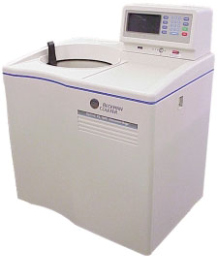Analytical ultracentrifugation
Analytical ultracentrifugation (AUC) is the study of the behaviour of macromolecules in solution under the influence of a strong gravitational force. Most macromolecules have a different density from the solvent surrounding them and so will sink (or float) in a strong enough field. Observations of dynamic behaviour ("sedimentation velocity") or of systems in equilibrium ("sedimentation equilibrium") can provide information about size, shape, density and conformational changes in proteins and other macromolecules. A wide variety of materials have been investigated by AUC, ranging in size from peptides to viruses, in origin from inorganic particles through synthetic polymers to living cells.
Applications
The main use of sedimentation velocity experiments is to examine whether a protein sample is homogeneous in solution or a mixture of forms (e.g. monomer/dimer, or aggregates). It may be possible to tell whether its shape changes significantly or if association with another component in the solution is taking place.
Sedimentation equilibrium is particularly useful for determination of molecular weights or subunit stoichiometry (monomer, dimer, trimer etc) in solution. Other methods such as size exclusion chomatography or electrophoresis are susceptible to errors caused by interactions with the matrix, and mass spectrometry, though very accurate, does not normally preserve subunit interactions. For example, AUC is recommended as an orthogonal technique for examination of biopharmaceuticals for aggregates, which may go unseen if they stick to SEC columns. AUC has also been used to analyse nucleic acids on density gradients - Meselson and Stahl's original experiments using 15N labelled DNA to show semiconservative replication were done by AUC.
Facilities
Beckman Optima XL/I
This machine was installed in September 2002. It is fitted with an absorption optical system capable of wavelengths between 200 and 750 nm (A values between 0.1 and 1.4) and the Rayleigh ("interference") system, which uses laser light to measure refractive index changes and is well suited to high protein concentrations (over 2 mg/ml) and study of substances without usable chromophores (e.g. polysaccharides).
The centrifuge will run at speeds up to 60000 rpm, though currently we only have cells rated to 48000 rpm for equilibrium and 42000 rpm for velocity experiments.
The cells are composed of epoxy centrepieces and quartz or sapphire windows, assembled in an aluminium housing. The rotors are of titanium, and run in a vacuum for best temperature stability. Although experiments are normally run at 20°C, the machine is capable of thermostatting from 5°C to over 50°C.
Rotors & cells
We have two rotors, an AN60Ti four hole, capable of 60000 rpm, and an AN50Ti 8-hole, which can be used up to 50000 rpm. All AUC runs require use of a single counterbalance cell for calibration purposes, which limits the maximum number of cells to three and seven respectively.
There are six double sector velocity cells and three six-sector equilibrium cells, plus a number of older cells "inherited" with the XL/A. The centrepieces are made of charcoal filled Epon (an epoxy resin) and the optical windows of quartz or sapphire. Sapphire has better mechanical properties for work at high speeds but quartz has better UV transmission at low wavelengths (<240 nm).
Each cell has sample compartments arranged in pairs for sample and reference - the optical measurements are always taken as the difference between these two to minimise optical and other artefacts. This means that for each sample a suitable reference buffer is required.
Samples
For velocity experiments about 450 ul sample is required ideally with absorption ~0.8-1 at the wavelength to be used. Equilibrium experiments need about 130 ul per sample, with absorption about 0.4. In both cases an equal volume of reference buffer per sample is necessary. The closer in composition this is to the sample, the better - for example, if the samples are prepared by dialysis, use the buffer from outside the dialysis bag as reference. Normally several samples are run at once - up to three for velocity experiments and up to nine for equilibrium; the samples may be of different concentrations or different conditions. These are only guidelines - I would normally expect to discuss sample preparation in detail with the user before embarking on a run. Inappropriately prepared samples are likely to result in useless data!
Links
- Reversible Associations in Structural and Molecular Biology - at The Boston Biomedical Research Institute. Links to many useful AUC websites
- Centre for Analytical Ultracentrifugation of Macromolecular Assemblies - at the University of Texas
- The Nottingham Centre for Molecular Hydrodynamics - at the University of Nottingham, run by Professors Steve Harding and Arthur Rowe
- US company Alliance Protein Laboratories run by John Philo - go to characterization for good explanations of several biophysical techniques
- Borries Demeler's data analysis software site - Go to Tutorials
- Beckman Coulter AUC resources
- SEDFIT - home page for Peter Schuck's widely used AUC analysis software


